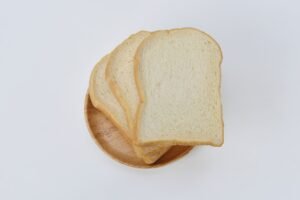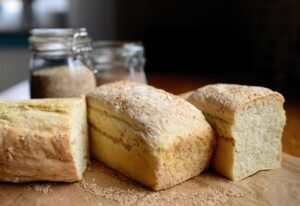Introduction
White bread, described by its delicate surface and gentle flavor, stays a staple in various kitchens universally. Notwithstanding its broad utilization, many neglects or misread its dietary substance. This article investigates the particular nourishing parts of a solitary cut of white bread, including calories, macronutrients like starches, proteins, and fats, as well as fundamental nutrients and minerals. By understanding these components, we intend to explain how white bread squeezes into a fair eating regimen and examine its potential well-being influences, giving a more educated point of view to ordinary utilization decisions.

Nutritional of One Slice of White Bread
Exactly when you gobble up a cut of white bread, you are on a very basic level eating food created utilizing refined wheat flour. Here’s what this simple slice brings to your diet:
- Calories: Each cut contains around 70 to 80 calories, making it a sensible choice whenever consumed with some restraint.
- Carbs: A cut gives 13 to 16 grams of sugars, transcendently from refined flour, which misses the mark on fiber and a few supplements found in entire grain bread. Ordinarily, it incorporates under 1 gram of dietary fiber and around 1 to 2 grams of sugar.
- Proteins: It offers an unassuming measure of protein, around 2 to 3 grams for every cut, contributing somewhat to day-to-day protein needs.
- Fats: For the most part, there is under 1 gram of fat for each cut. Assortments might contain somewhat more fat because of added oils or fats for flavor and surface.
- Nutrients and Minerals: Many white bread assortments are braced with fundamental supplements to forestall lacks. These incorporate iron, urgent for oxygen transport in the blood, and B nutrients like folic corrosive, fundamental for cell development and digestion. A few brands may likewise add calcium and vitamin D, however less usually.
- Sodium: The sodium content can differ, regularly going from 80 to 230 milligrams for each cut, a significant thought for those checking their admission.
Health Impact
Standard utilization of white bread can affect well-being in more ways than one:
- Glucose Levels: Delivered utilizing refined flour with the most fiber disposed of, the starches in white bread are quickly absorbed, provoking quick spikes and falls in glucose levels. This can be hazardous for individuals with diabetes or insulin hindrance.
- Weight Management: Its high glycemic record and low satiety level may not help weigh the board, as it can build craving and generally caloric admission.
- Digestive Health: The negligible fiber content does close to nothing to help stomach-related well-being, possibly prompting distress or issues.
- Nutritional Deficiencies: While braced, weighty dependence on white bread can prompt an absence of dietary variety and likely lacks fiber and different supplements more bountiful in entire grains.
- Heart Wellbeing: Successive utilization of high-glycemic-record food varieties like white bread is connected to expanded dangers of coronary illness, elevated cholesterol, and fatty substances.

Benefits
Despite potential drawbacks, white bread also offers benefits, especially when consumed in moderation:
- Energy Provision: It provides quick energy due to its high glycemic index, useful for those needing immediate fuel.
- Fortified Nutrients: Fortress helps meet day-to-day dietary necessities, advantageous in populations in danger of lack.
- Low Fat: Reasonable for low-fat weight control plans, it has insignificant fat substance.
- Adaptability and Availability: White bread is profoundly flexible and broadly accessible, making it a simple staple.
- Edibility: It could be simpler to process for those with specific stomach-related issues because of its lower fiber content.
Risks
The dangers related to customary or exorbitant utilization include:
- Supplement Lacks: It is in a general sense lower in fiber, supplements, and minerals diverged from whole grain bread.
- Glucose Spikes: Its high glycemic record can provoke quick blood glucose spikes, particularly unfriendly to those with diabetes.
- Weight Gain: Its penchant to build yearning can add to weight gain and heftiness.
- Cardiovascular Wellbeing Dangers: Connected to raised circulatory strain, elevated cholesterol, and coronary illness gambles.
- Impact on Digestive Health: The low fiber content can prompt obstruction and unfortunate stomach well-being.
Dietary Considerations
While integrating white bread into your eating routine, think about the accompanying:
- Control: Offset your admission with other supplement-thick food sources
- .Check for Stronghold: Decide on sustained assortments to assist with addressing supplement needs.
- Diet-Specific Needs: Be mindful of conditions like diabetes or gluten sensitivity.
- Pairing: Combine with nutritious foods to balance meals.
- Whole Grain Alternatives: Consider opting for whole-grain bread for additional health benefits.
Comparison with Other Breads
Understanding how white bread piles face different sorts of bread can assist you with pursuing more educated dietary decisions. Here is a correlation of white bread with other generally consumed bread types like entire wheat and multigrain:
1: Whole Wheat Bread:
- Supplement Content: Entire wheat bread is produced using the whole wheat portion, and that implies it contains the microorganism, endosperm, and grain. This outcomes in a higher fiber content, more nutrients and minerals, and by and large more protein than white bread. Whole wheat bread in like manner has a lower glycemic document, which is better for glucose control.
- Health Benefits: The higher fiber content in entire wheat bread assists with processing and gives a more noteworthy sensation of totality, which can support the weight of the board. The supplements found in entire grains like B nutrients, iron, magnesium, and selenium support different physical processes, including energy creation and safe reaction.
- Taste and Surface: Entire wheat bread will in general have a denser surface and a nuttier flavor contrasted with the delicate and fleecy surface of white bread. Certain individuals favor the extravagance in taste that entire grains offer of real value.
2: Multigrain Bread:
- Supplement Content: Multigrain bread can incorporate different entire grains like oats, grain, millet, and wheat, as well as extra parts like seeds and nuts. This variety in fixings ordinarily gives a higher substance of fiber and supplements contrasted with white bread.
- Health Benefits: The mix of various grains and seeds infers multigrain bread for the most part offers many enhancements, including omega-3 unsaturated fats from seeds like flaxseeds or chia seeds. These enhancements add to heart prosperity and decrease disturbance.
- Taste and Surface: Multigrain bread has a complicated surface that can go from chewy to crunchy, contingent upon the kinds and extents of grains and seeds utilized. Its flavor is additionally hearty and can upgrade the taste profile of dinners.
Rye Bread:
- Supplement Content: Rye bread, particularly when produced using entire rye, is very high in fiber and by and large has a lower glycemic file than white bread. It likewise gives great measures of iron, potassium, and some B nutrients.
- Medical advantages: The high fiber content in rye bread supports stomach-related well-being as well as assists in controlling blood with sugaring levels and keeping a solid weight.
- Taste and Surface: Rye bread regularly has a more extreme flavor and denser surface than white bread, which may be a mixed bag for some.
Choosing the Right Bread:
While white bread might be engaging for its delicate surface and gentle flavor, its wholesome impediments make it less great for incessant utilization, particularly for those with explicit well-being concerns like diabetes or coronary illness. Entire wheat and multigrain breads offer more medical advantages, including higher fiber content and a more extravagant exhibit of supplements. While picking bread, consider your general eating regimen, particular well-being needs, and individual taste inclinations to choose the sort that best accommodates your way of life.
Conclusion
In summary, while a cut of white bread gives a moderate measure of calories and fills in as a fast wellspring of energy, it isn’t the most nutritious decision that anyone could hope to find. Its low fiber content and high glycemic file may not suit everybody’s dietary requirements, especially for those with explicit well-being concerns like diabetes. While picking bread, it is helpful to consider entire grain choices, which offer more prominent nourishing advantages. Consideration ought to likewise be paid to by and large utilization propensities and part sizes to keep a fair eating regimen.
Understanding the full extent of white bread’s dietary benefits and well-being suggestions takes into account more educated choices that line up with individual well-being objectives and dietary necessities. For ideal well-being, incorporating various supplements and thick food sources while directing white bread admission can add to a more adjusted and refreshing eating design.
FAQs
What number of calories are in one cut of white bread?
Constantly, one cut of white bread contains around 70 to 80 calories.
Is white bread a good source of fiber?
No, white bread overall contains under 1 gram of dietary fiber per cut, making it a lamentable fiber source.
Can eating white bread affect my blood sugar levels?
To be sure, as a result of its high glycemic record, white bread can cause quicker risings in glucose levels, which is a fascinating point expecting that you have glucose the board concerns.
Are there any nutrients and minerals in white bread?
While not ordinarily affluent in supplements, most white bread is reinforced with supplements and minerals like iron and B supplements.
Is white bread vegetarian?
Many white breads are vegetarian, yet it means a lot to take a look at the mark for non-veggie lovers’ added substances like dairy or eggs.

